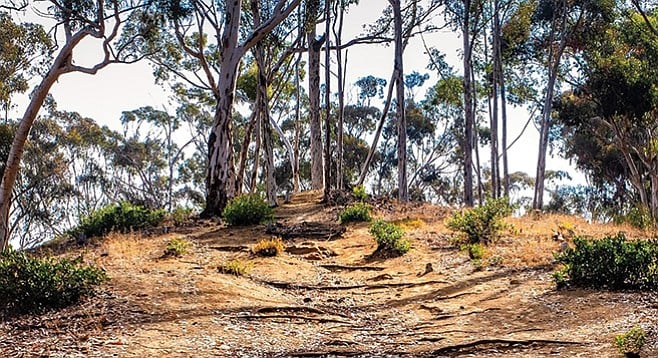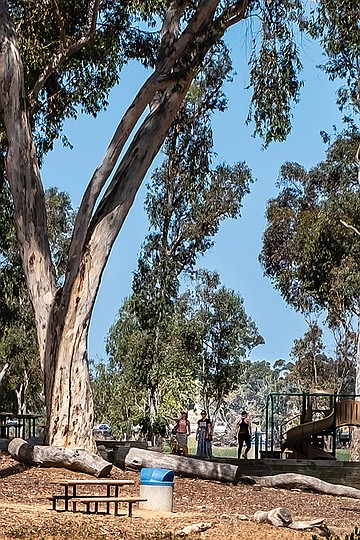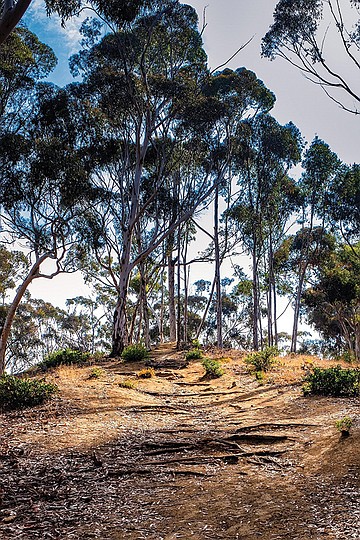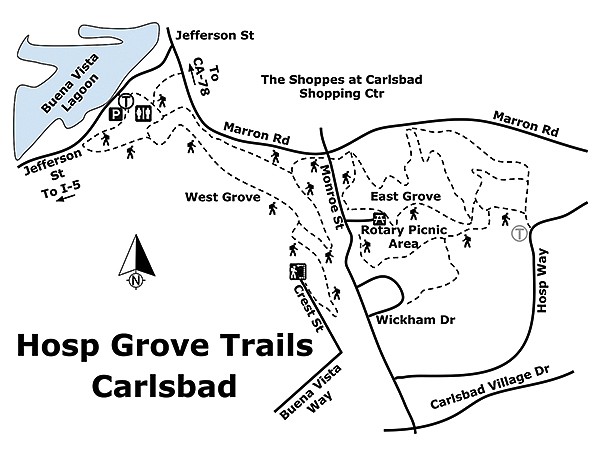 Facebook
Facebook
 X
X
 Instagram
Instagram
 TikTok
TikTok
 Youtube
Youtube


The many eucalyptus trees (Eucalyptus globulus) growing in this part of Carlsbad were originally planted by F.W. Hosp, an Oceanside nurseryman, who hoped to use the wood for railroad ties, bridges, and trestles. Hosp and his investors formed the Hosp Eucalyptus Corporation in 1907, and ultimately planted 45 of the 219 acres they owned with 1082 trees per acre. Unfortunately, as they began to harvest trees, they discovered that immature blue gum wood was not suitable for their purposes. The wood was too hard to drive railroad spikes into, and the wood tended to twist and warp as it dried.
Over the years, much of the land controlled by the Hosp Eucalyptus Corporation was sold for development. More recently, Carlsbad acquired the remaining 55 acres of the Grove to be used as City parkland and open space. These lands are now maintained largely through the efforts of dedicated volunteers.

The genus Eucalyptus contains over 700 species, almost all exclusively Australian natives, and an estimated 200 of these have been transplanted from their native home in Australia to California. Some of these species are not only beautiful but produce valuable products, including oils and wood. Several species of eucalyptus are drought tolerant and have become naturalized, both here and in locations throughout California.
However, eucalyptus plantations can and do cause significant problems. Most native California animals cannot eat eucalyptus. The trees are constantly dropping leaves, branches, seed pods and bark. The accumulated litter suppresses native vegetation, leaving less food for native animals. Dense eucalyptus stands with their accumulated litter are also fire prone, and the severity of several California wildfires, such as the 1991 Oakland hills fire that destroyed 2800 homes and killed 25 people, has been attributed to the abundance of eucalyptus in the forests on those hills.
The Grove trails form a network, so it is difficult to create a continuous loop route. To complete a 3-mile walk, take the 1.5 mile West Grove trails, then cross Monroe Street and hike several of the East Hosp Grove trails. From the main entrance off Jefferson Street, begin your hike on the trail going west from the parking lot. As it rises up the hillside, it will give you satisfying views of the Buena Vista Lagoon. After hiking less than 0.1 mile, the trail makes a hairpin turn and continues climbing up the slope for even better lagoon vistas. Note the large logs that remain on the slopes lining some parts of the trail, apparent remnants of logging activity that occurred here at some point in the past.
After reaching a high point, the trail turns sharply south and becomes parallel with Monroe Street. Note the near absence of typical native California shrubs. Most likely, the eucalyptus trees with their deep roots and accumulated litter suppressed the growth and reproduction of coastal sage scrub or maritime chaparral species that originally grew here. Occasionally you will come to clusters of large native lemonadeberry bushes, but even these clusters are sparsely scattered amongst the trees.
After hiking about 0.5 mile, the trail begins to rise again. Shortly you will come to a fork. Take the right fork, which will lead you to the top of the ridge, with a trailhead on Crest Street. Unusual non-native exotics found here include succulents such as jade plant and pig’s ear.
After reaching Crest Street, turn around and go back the way you came, but upon nearing Monroe Street, find the lower trail going north and follow it back to the Monroe and Marron Street intersection. Here you can safely cross Monroe to the East Hosp Grove Trails.
From the Rotary picnic and parking area in the East Grove, find the main trail going east, up the slope. On reaching the top, you will find trails that continue east across a gently sloping plateau. Eventually, the main trail will take you to a trailhead off Hosp Way, another entrance to the Grove. From here, find a trail heading west and take it. Because of the openness of the forest and the scarcity of an understory, it is relatively easy to find trails that interest you and take them back to the Monroe-Marron intersection. Crossing the intersection, you will find a trail continuing west to the main entrance and your vehicle.

Directions: (Carlsbad) From I-5, take exit 51A Los Flores Drive. Turn left on Los Flores, cross back over the freeway, and shortly come to the intersection of Los Flores and Jefferson St. Make a right turn on Jefferson and follow it 0.6 mile to the main Hosp Grove entrance and parking area. Here you will find picnic tables and a children’s play area, in addition to the trailhead for the West Grove hiking trails. There is also a porta-potty, the only facility in the park.
Hiking length: 3 miles, loop. Allow 1.5 hours.
Difficulty: Moderately easy with an elevation gain/loss of 800 feet. Hikers, leashed dogs, and bicyclists are allowed on the trails.



The many eucalyptus trees (Eucalyptus globulus) growing in this part of Carlsbad were originally planted by F.W. Hosp, an Oceanside nurseryman, who hoped to use the wood for railroad ties, bridges, and trestles. Hosp and his investors formed the Hosp Eucalyptus Corporation in 1907, and ultimately planted 45 of the 219 acres they owned with 1082 trees per acre. Unfortunately, as they began to harvest trees, they discovered that immature blue gum wood was not suitable for their purposes. The wood was too hard to drive railroad spikes into, and the wood tended to twist and warp as it dried.
Over the years, much of the land controlled by the Hosp Eucalyptus Corporation was sold for development. More recently, Carlsbad acquired the remaining 55 acres of the Grove to be used as City parkland and open space. These lands are now maintained largely through the efforts of dedicated volunteers.

The genus Eucalyptus contains over 700 species, almost all exclusively Australian natives, and an estimated 200 of these have been transplanted from their native home in Australia to California. Some of these species are not only beautiful but produce valuable products, including oils and wood. Several species of eucalyptus are drought tolerant and have become naturalized, both here and in locations throughout California.
However, eucalyptus plantations can and do cause significant problems. Most native California animals cannot eat eucalyptus. The trees are constantly dropping leaves, branches, seed pods and bark. The accumulated litter suppresses native vegetation, leaving less food for native animals. Dense eucalyptus stands with their accumulated litter are also fire prone, and the severity of several California wildfires, such as the 1991 Oakland hills fire that destroyed 2800 homes and killed 25 people, has been attributed to the abundance of eucalyptus in the forests on those hills.
The Grove trails form a network, so it is difficult to create a continuous loop route. To complete a 3-mile walk, take the 1.5 mile West Grove trails, then cross Monroe Street and hike several of the East Hosp Grove trails. From the main entrance off Jefferson Street, begin your hike on the trail going west from the parking lot. As it rises up the hillside, it will give you satisfying views of the Buena Vista Lagoon. After hiking less than 0.1 mile, the trail makes a hairpin turn and continues climbing up the slope for even better lagoon vistas. Note the large logs that remain on the slopes lining some parts of the trail, apparent remnants of logging activity that occurred here at some point in the past.
After reaching a high point, the trail turns sharply south and becomes parallel with Monroe Street. Note the near absence of typical native California shrubs. Most likely, the eucalyptus trees with their deep roots and accumulated litter suppressed the growth and reproduction of coastal sage scrub or maritime chaparral species that originally grew here. Occasionally you will come to clusters of large native lemonadeberry bushes, but even these clusters are sparsely scattered amongst the trees.
After hiking about 0.5 mile, the trail begins to rise again. Shortly you will come to a fork. Take the right fork, which will lead you to the top of the ridge, with a trailhead on Crest Street. Unusual non-native exotics found here include succulents such as jade plant and pig’s ear.
After reaching Crest Street, turn around and go back the way you came, but upon nearing Monroe Street, find the lower trail going north and follow it back to the Monroe and Marron Street intersection. Here you can safely cross Monroe to the East Hosp Grove Trails.
From the Rotary picnic and parking area in the East Grove, find the main trail going east, up the slope. On reaching the top, you will find trails that continue east across a gently sloping plateau. Eventually, the main trail will take you to a trailhead off Hosp Way, another entrance to the Grove. From here, find a trail heading west and take it. Because of the openness of the forest and the scarcity of an understory, it is relatively easy to find trails that interest you and take them back to the Monroe-Marron intersection. Crossing the intersection, you will find a trail continuing west to the main entrance and your vehicle.

Directions: (Carlsbad) From I-5, take exit 51A Los Flores Drive. Turn left on Los Flores, cross back over the freeway, and shortly come to the intersection of Los Flores and Jefferson St. Make a right turn on Jefferson and follow it 0.6 mile to the main Hosp Grove entrance and parking area. Here you will find picnic tables and a children’s play area, in addition to the trailhead for the West Grove hiking trails. There is also a porta-potty, the only facility in the park.
Hiking length: 3 miles, loop. Allow 1.5 hours.
Difficulty: Moderately easy with an elevation gain/loss of 800 feet. Hikers, leashed dogs, and bicyclists are allowed on the trails.
Comments